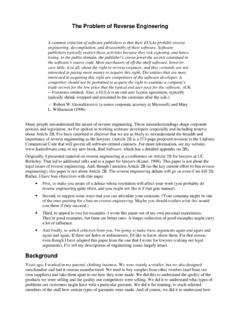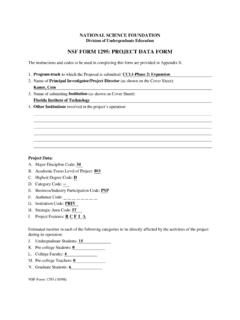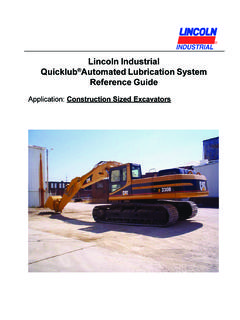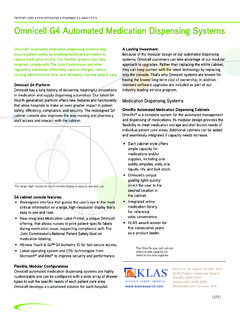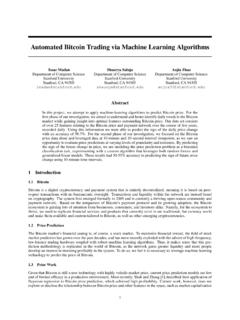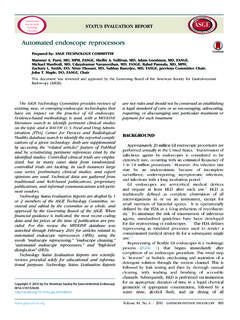Transcription of Improving the Maintainbility of Automated Test …
1 Copyright Cem TestingPage 1 Improving the Maintainability of Automated Test Suites1 Paper Presented at Quality Week 97 Copyright Cem Kaner. All rights black box, GUI-level regression test tools are popular in the industry. According to thepopular mythology, people with little programming experience can use these tools to quickly createextensive test suites. The tools are (allegedly) easy to use. Maintenance of the test suites is (allegedly) nota problem. Therefore, the story goes, a development manager can save lots of money and aggravation,and can ship software sooner, by using one of these tools to replace some (or most) of those pesky myths are spread by tool vendors, by executives who don t understand testing, and even by testersand test managers who should (and sometimes do) know companies have enjoyed success with these tools, but several companies have failed to use thesetools February, thirteen experienced software testers met at the Los Altos Workshop on Software Testing(LAWST)2 for two days to discuss patterns of success and failure in development of maintainable blackbox regression test suites.
2 Our focus was pragmatic and experience-based. We started with the recognitionthat many labs have developed partial solutions to automation problems. Our goal was to pool practicalexperience, in order to make useful progress in a relatively short time. To keep our productivity high, weworked with a seasoned facilitator (Brian Lawrence), who managed the were the participants: Chris Agruss (Autodesk), Tom Arnold (ST Labs), James Bach (ST Labs),Jim Brooks (Adobe Systems, Inc.), Doug Hoffman (Software Quality Methods), Cem Kaner ( ),Brian Lawrence (Coyote Valley Software Consulting), Tom Lindemuth (Adobe Systems, Inc.), BrianMarick (Testing Foundations), Noel Nyman (Microsoft), Bret Pettichord (Unison), Drew Pritsker(Pritsker Consulting), and Melora Svoboda (Electric Communities). Organizational affiliations are givenfor identification purposes only.
3 Participants views are their own, and do not necessarily reflect the viewsof the companies paper integrates some highlights of that meeting with some of my other testing s the Problem?There are many pitfalls in Automated regression testing. I list a few here. James Bach (one of the LAWST participants) lists plenty of others, in his paper Test Automation Snake Oil. 3 1 Parts of this paper were published in Kaner, C., Pitfalls and Strategies in Automated Testing IEEEC omputer, April, 1997, p. 114-116. I ve received comments from several readers of that paper and of apreviously circulated draft of this longer one. I particularly thank David Gelperin, Mike Powers, andChris Adams for specific, useful A Los Altos Workshop on Software Testing (LAWST) is a two-day meeting that focuses on a difficulttesting problem.
4 This paper describes the first LAWST, which was held on February 1-2, 1997. Thesemeetings are kept small and are highly structured in order to encourage participation by each attendee. Asthe organizer and co-host of the first LAWST, I ll be glad to share my thoughts on the structure andprocess of meetings like these, with the hope that you ll set up workshops of your own. They areproductive meetings. Contact me at or check my web page, Windows Tech Journal, October Cem TestingPage 2 Problems with the basic paradigm:Here is the basic paradigm for GUI-based Automated regression testing:4(a) Design a test case, then run it.(b) If the program fails the test, write a bug report. Start over after the bug is fixed.(c) If the program passes the test, automate it. Run the test again (either from a script or with theaid of a capture utility).
5 Capture the screen output at the end of the test. Save the test case andthe output.(d) Next time, run the test case and compare its output to the saved output. If the outputs match,the program passes the problem: this is not cheap. It usually takes between 3 and 10 times as long (and can take muchlonger) to create, verify, and minimally document5 the Automated test as it takes to create and run the testonce by hand. Many tests will be worth automating, but for all the tests that you run only once or twice,this approach is people recommend that testers automate 100% of their test cases. I strongly disagree with this. Icreate and run many black box tests only once. To automate these one-shot tests , I would have to spendsubstantially more time and money per test. In the same period of time, I wouldn t be able to run as manytests. Why should I seek lower coverage at a higher cost per test?
6 Second problem: this approach creates risks of additional costs. We all know that the cost of findingand fixing bugs increases over time. As a product gets closer to its (scheduled) ship date more peoplework with it, as in-house beta users or to create manuals and marketing materials. The later you find andfix significant bugs, the more of these people s time will be wasted. If you spend most of your earlytesting time writing test scripts, you will delay finding bugs until later, when they are more problem: these tests are not powerful. The only tests you automate are tests that the program hasalready passed. How many new bugs will you find this way? The estimates that I ve heard range from 6%to 30%. The numbers go up if you count the bugs that you find while creating the test cases, but this isusually manual testing, not related to the ultimate Automated problem: in practice, many test groups automate only the easy-to-run tests .
7 Early in testing,these are easy to design and the program might not be capable of running more complex test cases. Later,though, these tests are weak, especially in comparison to the increasingly harsh testing done by a skilledmanual consider maintainability:Maintenance requirements don t go away just because your friendly Automated tool vendor forgot tomention them. Two routinely recurring issues focused our discussion at the February LAWST meeting. When the program s user interface changes, how much work do you have to do to update thetest scripts so that they accurately reflect and test the program? 4 A reader suggested that this is a flawed paradigm ( a straw paradigm ). It is flawed, but that s theproblem that we re trying to deal with. If you re not testing in a GUI-based environment (we spent mostof our time discussing Windows environments), then this paper might not directly apply to your this paradigm is widely used in the worlds that we test A reader suggested that this is an unfair comparison.
8 If we don t count the time spent documentingmanual tests , why count the time spent documenting the Automated tests ? In practice, there is adistinction. A manual test can be created once, to be used right now. You will never reuse several of thesetests; documentation of them is irrelevant. An Automated test is created to be reused. You take significantrisks if you re-use a battery of tests without having any information about what they Cem TestingPage 3 When the user interface language changes (such as English to French), how hard is it torevise the scripts so that they accurately reflect and test the program?We need strategies that we can count on to deal with these are two strategies that don t work:Creating test cases using a capture tool: The most common way to create test cases is to use the capturefeature of your Automated test tool.
9 This is your first course on programming, you probably learned not to write programs like this:SET A = 2 SET B = 3 PRINT A+BEmbedding constants in code is obviously foolish. But that s what we do with capture utilities. We createa test script by capturing an exact sequence of exact keystrokes, mouse movements, or commands. Theseare constants, just like 2 and 3. The slightest change to the program s user interface and the script isinvalid. The maintenance costs associated with captured test cases are utilities can help you script tests by showing you how the test tool interprets a manual test are not useless. But they are dangerous if you try to do too much with test cases on an ad hoc basis: Test groups often try to create Automated test cases in theirspare time. The overall plan seems to be, Create as many tests as possible. There is no unifying plan ortheme.
10 Each test case is designed and coded independently, and the scripts often repeat exact sequences ofcommands. This approach is just as fragile as the for SuccessWe didn t meet to bemoan the risks associated with using these tools. Some of us have done enough ofthat on and in other publications. We met because we realized that severallabs had made significant progress in dealing with these problems. But information isn t being sharedenough. What seems obvious to one lab is advanced thinking to another. It was time to take stock of whatwe collectively knew, in an environment that made it easy to challenge and clarify each other s are some suggestions for developing an Automated regression test strategy that works:1. Reset management expectations about the timing of benefits from automation2. Recognize that test automation development is software Use a data-driven Use a framework-based Recognize staffing Consider using other types of Reset management expectations about the timing of benefits from all agreed that when GUI-level regression automation is developed in Release N of the software, mostof the benefits are realized during the testing and development of Release N+1.




